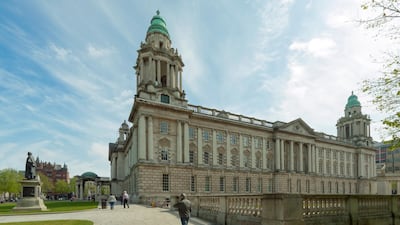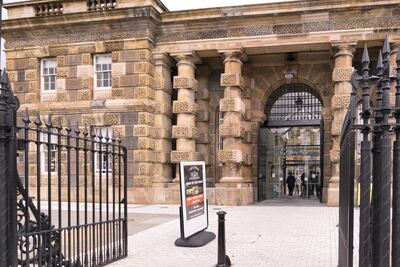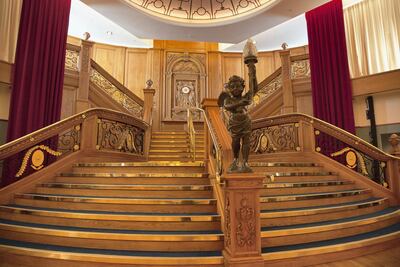Why Belfast?
Belfast is the renaissance city of the United Kingdom. Since 1998, when decades of violence between Catholic and Protestant communities were largely brought to an end by the Good Friday Agreement, the city has benefited from a "peace dividend" which led to hundreds of millions in investment as new hope took root.
Its proud architectural heritage can be seen in the many beautiful Georgian, Victorian and Edwardian buildings which remain in excellent condition as well as modern structures such as Titanic Belfast.
Belfast has also become a destination for serious foodies, making the most of the excellent produce on offer in Northern Ireland, with many venues offering traditional cuisine as well as spreading their wings to bring new and exotic tastes to the region's capital. And the exploits of one of its most famous sons – Manchester United's mesmeric winger George Best – after whom one of the airports serving the city is named, are to be celebrated with the opening of a themed hotel.
A comfortable bed
Smack bang in the centre of the city, the award-winning Bullitt Hotel (www.bullitthotel.com) is the ideal place to make a base. It happily admits to a "no-nonsense philosophy", which means you don't waste your cash on unnecessary extras that will eat up your holiday spending money – instead there are 74 modern, well-equipped rooms with twin and double options –from £120 (Dh589) a night. The hotel also has a restaurant, as well as a rooftop bar and garden which offer stunning views.
Book a table
One of the restaurants at the forefront of the city's bustling scene is Edo (www.edorestaurant.co.uk), whose name means "I eat" in Latin. Chef patron Jonny Elliott worked for such culinary luminaries as Gordon Ramsay and Gary Rhodes, and set his sights on providing a "European dining experience in the heart of Belfast". The menu is split between tapas-style sharing dishes, from £5 (Dh25), and meat and fish dishes cooked on a Bertha – a wood-fired oven that uses pear and apple-tree logs – and peat to give a unique flavour. That aids delicious offerings such as beef cheeks with cabbage at £13.50 (Dh66) and salt-aged lamb – £16 (Dh79). There are also hulking Flintstone-esque sirloin and rib-eye steaks from the best local farms at £26 (Dh128).
For an affordable and more traditional take on Northern Irish cuisine, head to Darcy's of Belfast (www.darcysbelfast.co.uk), a city institution on the Golden Mile described by the Belfast Telegraph as a "little family-run sanctuary". It features a "777 menu" that allows you to eat the highly recommended Irish stew, among other mains, for £7.77 (Dh38). There are also excellent vegetarian and vegan options available.
Find your feet
Belfast was one of the engines of the Industrial Revolution, and money poured into the city from the Irish linen industry, tobacco production and shipbuilding. The legacy of this wealth can be seen in some of the grand civic buildings spread across the compact centre, such as City Hall (www.visitbelfast.com). Constructed using Portland stone and topped with a copper dome, the building was finished in 1906 and commemorated the granting of city status 18 years before. Free tours of its ornate interior should be on every traveller's itinerary.
The Ulster Museum (www.nmni.com) in the Botanic Gardens tells the story of the north of Ireland through its fine collection of Irish art and scientific exhibits which explore what the land was like in times stretching back thousands of years. A tour of the gardens is also recommended: the 190-year-old institution is home to the Palm House, featuring plants from around the world, and the Tropical Ravine, which houses seed plants of great antiquity, banana trees and orchids.
For an exploration of some of the darker sides of the city's past, take a trip to the Crumlin Road Gaol (www.crumlinroadgaol.com). During its 150 years of service, the prison, which was closed in 1996, was home to murderers and suffragettes, as well as prisoners from both sides of the sectarian divide.
Another thoughtful excursion is the Belfast Political Tour. Formerly incarcerated Republican and Loyalist prisoners take you on a guided tour through, respectively, the Catholic and Protestant areas of the city, which sadly remain divided by tall, concrete “peace walls” even today.
__________________
Read more about Ireland:
On a Game of Thrones trail in Northern Ireland
In the footsteps of literary greatness in Ireland
Hotel insider: The Dean, Dublin, Ireland
__________________
Meet the locals
Singer-songwriter Van Morrison hails from Belfast, and if you fancy escaping the city for a morning, you can follow in his footsteps. On the song Coney Island from his 1989 album Avalon Sunset, he describes an idyllic Sunday morning driving along the stunning County Down coastline. Head south-east from Belfast and attempt to tick off the stops that he makes in the song, although not necessarily in the order that he suggests: stop off at St John's Point lighthouse for birdwatching; visit the beautiful Strangford Lough; drive through Shrigley taking pictures; see the castle dating from 1180 in Killyleagh; grab the Sunday papers in Lecale District; enjoy the beautiful beach at Coney Island; and pick up some potted herrings in Ardglass.
Shoppers’ paradise
St George's Market (East Bridge Street) was built in the 1890s and is one of the finest examples of its kind in the British isles. It hosts markets on Fridays, Saturdays and Sundays, with stalls selling food and drink, antiques, books, clothes, pottery and metalwork. You can also eat on the hoof as there numerous stalls selling hot and cold food and there are live bands playing local music.
What to avoid
As much as you may be tempted to take a trip to the Giant’s Causeway, a collection of 40,000 basalt columns which was formed 60 million years ago by volcanic activity, and which is a Unesco World Heritage Site, be warned that if you don’t have a car, you may end up using an entire precious day of your stay getting there and back on public transport.
Don’t miss
The legacy of the Titanic, which was built in the Harland & Wolff shipyard, looms large across the city. There are memorials in the grounds of the City Hall, and since 2012, it has been celebrated in Titanic Belfast, which was voted the leading global travel attraction at the 2016 World Travel Awards. A short walk from the city centre, the £97 million (Dh476m) attraction is shaped like the bows of a ship and stretches across nine galleries and four floors. Interactive installations transport you back to the world of Edwardian Britain to tell the tragic story of the ship that they said could never sink.
Also located in the Titanic Quarter is the SS Nomadic, a tender ship that transported passengers from Cherbourg harbour to dock the Titanic before it set off on its doomed journey across the Atlantic. Fully restored to its original glory, you can explore the ship for yourself.
Getting there
Emirates (www.emirates.com) and Etihad (www.etihad.com) fly direct from the UAE to Dublin twice daily, with fares starting from about Dh3,200, including taxes. The flight time is about eight hours. The train from Dublin to Belfast takes two hours and 15 minutes,
or it is a one-hour-and-50-minute drive.



